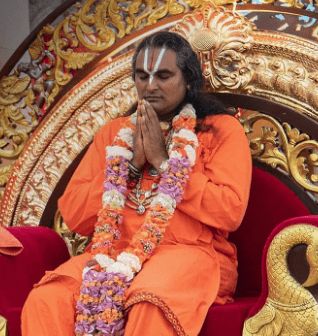There are seven shared tenents or principles that Hindus all tend to abide by. To be clear, they all accept these concepts and accept that they have a relationship to each other. What that means principally and how that shows up in practice differ widely.
-
Atma
‘An eternal fragment of Myself becomes embodied as the living beings – jīvas – within this mortal world. It acquires the five senses, and the mind, which is the sixth, all of which reside in this material nature.’ Bhagavad Gita, 15.7
The atma, or soul, is the very divinity of the Self. It is such a central point to all Hindu philosophy that much of that exploration has been in pursuit of that Truth. It is the very core of who we are.
Within the Vaisishtaadvaita philosophy, the atma is an infitismal part of God. It is the same as God in quality but not in quantity. It it pure, unadulturated Love that exists in an eternal, enduring, ever-growing love-relationship with God. Whereas in the Advaita philosophy, the atma is seen as equal to God both in quality and quantity and to merge back into complete awareness of that reality.
-
Samsara
‘Arjuna, whatever state one remembers when leaving the body, that state one will certainly attain after death. For a person’s condition is the inevitable result of what has been dwelt upon throughout one’s life.’ - Bhagavad Gita, 8.6
Samsara, or reincarnation, is the cycle of birth and death. We are born to live out certain aspects of our karma, we die, and our soul takes up a new body. This cycle is repeated adnauseum but it is not eternal. There is an end that is found in moksha, or liberation. According to Understanding Hinduism, ‘Each incarnation is one story, one episode in a much grander cosmic journey. As we move through this jorueny, we learn and achieve higher states of consicousness. Life therefore is not a test to see if we can choose the right belief system, it is an experience; a long process of growth and evolution.’
-
Karma
‘Giving up the fruits of action, the yogī attains everlasting peace. But the one who is attached to the results of action, impelled by desire, is subject to bondage.’ - Bhagavad Gita, 5.12
Karma is the cosmic law of action and reaction. It’s the governing law of samsara, and the momentum that makes life happen and allows us to go on having experiences in the world until we become free of our karma through spiritual practices and attain liberation.
-
Moksha
‘Having reached the highest perfection and attaining Me, the great ones never again take rebirth in this world which is transient and full of misery.’ - Bhagavad Gita, 8.15
Moksha means liberation. It’s specifically liberation from samsara or the cycle of birth and death. We liberate ourselves, or are liberated through grace, from the material existence and we reach the only eternal state or abode. The methodolgy for this changes between paths and traditions. For some, moksha is only obtained by the act of surrender and the loving grace of God. For others, it is about inquriy and contemplation. Regardless, these methods both require the seeker to detach from the world and move beyond the influence of karma.
-
Dharma
‘But behind the idea of dharma is the understanding that everyone is equal, because we all have the divine atma within, but not everybody is the same. We are all unique and have a specific indidivudal purpose. The challenge of life is to stay aligned with this purpose at all times. This requires insight, acceptance, and concious awareness of our soul.’ - Understanding Hinduism, pg 16
Dharma is a bit of a strange word as it holds many meanings. In its most literal translation, it means the right way, path or purpose. The principal is built on the understanding the everything in the universe as a set rhyme and reason for its existence. There are three types of dharma:
- Dharma of the soul - this is to attain moksha
- Dharma of the individual - the notion that every person as their own role and purpose to fulfill in this world
- Dharma of action - the twelve pillars or tenents of action that support us in how we live.
-
Brahman
‘One should meditate on the all-knowing Supreme Person. The one who is the oldest and supreme Controller of all. His Form is inconceivable, more subtle than an atom, and the maintainer of everything. He is brilliant like the Sun and beyond all darkness.’ Bhagavad Gita, 8.9
Think of Brahman as the reality that underpins all things. He is the creator, foundation, and sustainer of all that exists. Brahman is the absolute Truth one aims to experience as a result of moksha. In some traditions, Brahman is impersonal and formless. There are no qualities or characteristics that can be ascribed to this Brahman. In other traditions, Brahman is personal and has a form and even a name like Narayana or Krishna. This Brahman is the well-wisher and grace-granter of the world and actively intervenes on behalf of those who worship Him.
-
Srishiti (and Pralaya)
‘At the beginning of a Day of Brahmā all beings come forth from the unmanifest, and when the Night comes, they are dissolved back into the unmanifested state.’ Bhagavad Gita, 8.18
In Hinduism, time is cyclical, not linear. Think of it like a spiral, rather than a circle. The cycles repeat but there may be variation in them. Srishti is the act of projection - the moment where all of creation is brough into a manifested world. As the cycle completes, pralaya, or dissolution, takes place. When this happens, all of creation is withdrawn into a dormant, condensed state.
A Verse to Unite Them All
These seven tenents make up the common concepts shared within the Hindu faith. As stated, the concepts may be shared but what that means practically varies widely. The Rig Veda contains a specific verse that provides support to this diversity in unity. It states, ‘The Truth is one but the wise speak of it in many ways.’
There are many ways to interpret the Truth and the path to unravel it can be understood in the analogy of the five blindfolded men and the elephant. As the story goes, five men were taken to an elephant, given the opportunity to touch it, and then identify what it was. One found the tail and insisted it was a rope. Another found its leg and said it was a tree trunk. And so on. Eventually, they were granted sight and saw the elephant. Nonetheless, they each described it differently. Through direct-first hand experience, they found the Truth (in the elephant) but spoke of it in the various ways that made understanding it accessible.
Discover the beauty of Hinduism with our free e-book - Understanding Hinduism. Download your copy now!








